The path of "Vityaz"
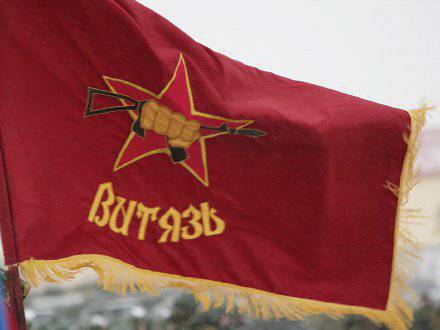 The governments of many countries have long been confronted with the threat of terrorism and have come to the conclusion that special security forces should be engaged in the fight against this world evil.
The governments of many countries have long been confronted with the threat of terrorism and have come to the conclusion that special security forces should be engaged in the fight against this world evil.The political leadership of the Soviet Union began to consider countering terrorism as one of the most important state tasks at the end of the 70s of the last century. And one of the first domestic counter-terrorism units was a special-purpose training company. A separate motorized rifle division for them. F. Dzerzhinsky, the decision on the formation of which was taken by the Minister of Internal Affairs of the USSR on the eve of the XXII Olympic Games in Moscow. It was this unit that became the forerunner of the legendary Vityaz squadron and the Special Purpose Center ODONA, which was later created on its basis.
29 December 1977 of the year - the start date of the formation of the first special forces unit in the system of the internal forces of the USSR Ministry of Internal Affairs. Its creation took place on the basis of the 9 Company of the 3 Battalion of the 2 Regiment of the OMSDON.
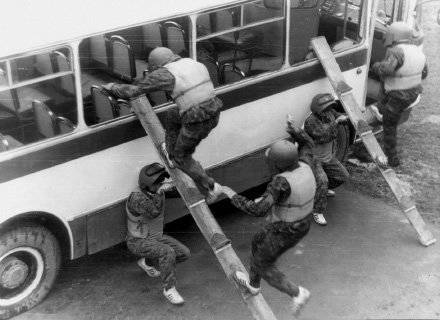 The relevant order of the Minister of the Interior stated: "The selection and recruitment of a special-purpose training company by officers, warrant officers, sergeants and military servicemen shall be carried out from among the disciplined, possessing the necessary physical and moral-psychological qualities of the military personnel of the internal troops."
The relevant order of the Minister of the Interior stated: "The selection and recruitment of a special-purpose training company by officers, warrant officers, sergeants and military servicemen shall be carried out from among the disciplined, possessing the necessary physical and moral-psychological qualities of the military personnel of the internal troops."Time for the creation of a unique unit was given a very limited, the terms were very tight. In January, 1978 began recruiting URSN officer personnel, coordinating platoons, developing a training program. At the same time, the unit, equipped with the best military personnel of the 2 regiment, began practical exercises and training.
Already in February, the special forces held the first demonstrative lesson for the leadership of the troops, after which, for three months, the training center of the compound conducted intensive preparations for the demonstration performance. It was there that the first military special forces were to hold the exam in front of the Minister of the Interior. By this time, 25 first spotted berets were sewed by special order for the company’s servicemen.
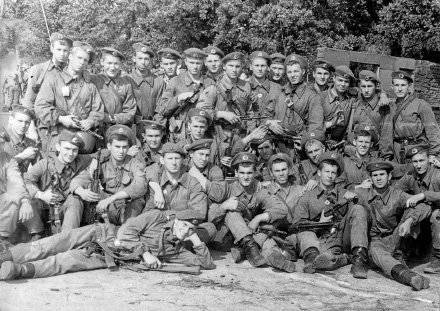 1 June 1978 of the year, after a successful demonstration lesson, was officially recognized the need for the existence of special forces units in the system of the Ministry of Interior. And began a serious purposeful work! Her first months showed that in order to improve the quality of training for servicemen serving in conscription, special units should be introduced in special units. And they appeared in URSN states in 1979 year.
1 June 1978 of the year, after a successful demonstration lesson, was officially recognized the need for the existence of special forces units in the system of the Ministry of Interior. And began a serious purposeful work! Her first months showed that in order to improve the quality of training for servicemen serving in conscription, special units should be introduced in special units. And they appeared in URSN states in 1979 year.In 1980, the first special forces unit of the internal troops opened an account with their combat affairs. In June, the company performed security tasks in the area of Vnukovo Airport, where the An-24 plane crashed. In July-August, she was in combat duty during the XXII Olympic Games, being in constant readiness on the first signal to come forward to protect public order and public security at any of the Olympic facilities.
Since then, there have been dozens, hundreds of successfully carried out operations, many of which would be honored to have in your assets the elite anti-terror units of various countries of the world ...
Hot spot time
In October, 1981, the personnel of URSN OMSDON took part in a special operation to eliminate riots in Ordzhonikidze (now Vladikavkaz). 18 December of the same year, the “knights”, together with Group A of the KGB of the USSR, released the hostages taken by criminals in one of the schools of the city of Sarapul of the Udmurt Autonomous Soviet Socialist Republic. In the autumn of 1982, the special forces of the internal troops were involved in the elimination of the riots perpetrated by draftees from the North Caucasus who took the train through Moscow to Yaroslavl.
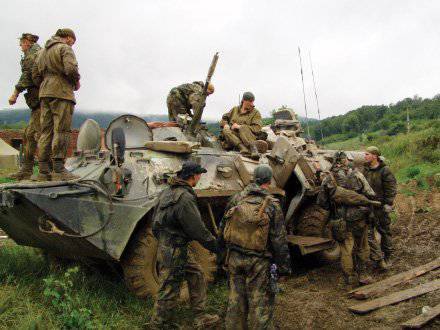 The first years of the existence of the special forces of the law enforcement troops and the first operations carried out by them showed the need to independently select and train recruits from among the draftees. For these purposes, in July 1984 of the year, a training platoon was introduced into the URST staff.
The first years of the existence of the special forces of the law enforcement troops and the first operations carried out by them showed the need to independently select and train recruits from among the draftees. For these purposes, in July 1984 of the year, a training platoon was introduced into the URST staff.In November of the same year, the “knights” successfully completed a particularly important government assignment to assist employees of the USSR Prosecutor General's Office during the investigation of the so-called “Uzbek case”. In July, the 1985 Company was on alert during the World Festival of Youth and Students, held in Moscow.
21 September 1986 of the year URSN OMSDON together with Group A of the KGB of the USSR participated in a special operation to free the plane hijacked by terrorists at the airport of the city of Ufa.
1988 year became one of the most intense in the military biography of the “knights”. In February-March, they participated in the suppression of mass riots, pogroms, robberies and outrages against the local population in Sumgayit of the Azerbaijan SSR, searched weapons in the places of its illegal storage, they seized stolen valuables from criminals, protected the most important objects of the republican Ministry of Internal Affairs in places with difficult operational situation. In July of the same year, they took part in a special operation to unblock the Zvartnots airport of the city of Yerevan. In September, eliminated riots in the Azerbaijani capital itself. In November-December, they were transferred to Armenia, where special forces provided a state of emergency.
This year is also notable for the fact that it was in the eighty-eighth that Sergei Ivanovich Lysyuk, who then headed the “knights”, had the idea of conducting an exam for the right to wear a keeper beret. Now it is difficult to imagine, but at first she did not find understanding among some representatives of the command of the troops, who believed that such a headdress should be worn by all special-purpose soldiers. Therefore, the first tests were carried out under the guise of complex and control and testing classes.
But time has taken its toll! The actions of the “krapovikov” in special operations, their moral and psychological hardening proved the importance of conducting such tests, which became officially recognized in the 1993 year: On May 31, Colonel-General Anatoly Sergeyevich Kulikov, who headed the Interior Troops of Russia at that time, approved the “Provision on qualification tests soldiers on the right to wear krapovogo beret ".
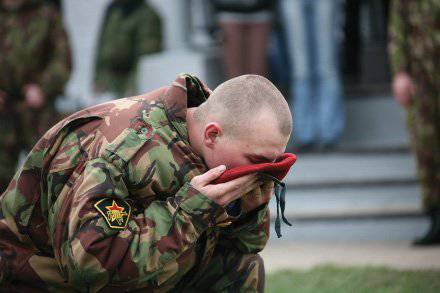 Taking into account the nature and content of the exam, its role in the training and education of special forces, the ritual of handing a keeper beret was developed, which at the same time became a reward for courage, resilience, combat skills, and a sign of high professional qualifications, and a symbol of valor and honor of special forces of internal troops.
Taking into account the nature and content of the exam, its role in the training and education of special forces, the ritual of handing a keeper beret was developed, which at the same time became a reward for courage, resilience, combat skills, and a sign of high professional qualifications, and a symbol of valor and honor of special forces of internal troops.A military biography of the detachment continued. In May, 1989, the special forces released the hostages captured by criminals in the detention center of the city of Kizel and in the corrective labor colony of the village of Lesnoe. In June, they participated in an operation to curb nationalist terrorism unprecedented in scale and cruelty, eliminate mass riots, disarm extremists, escort convoys with refugees in the Fergana region of the Uzbek SSR, and eliminate mass riots in the Mangyshlak region of the Kazakh SSR. In July, clashes on interethnic grounds in the Abkhaz ASSR were prevented, and illegally stored weapons were seized from the population and militants. In November, together with law enforcement agencies, they participated in measures to restore public order in the Moldavian SSR.
The involvement of internal troops to participate in the resolution of interethnic conflicts necessitated an increase in the number, improvement of the structure and training of special-purpose units. In December, a special-purpose training battalion was created on the basis of the URSN.
In 1990, Transcaucasia became the main region for the use of "knights". In January, they assisted border guards in protecting the state border in the Nakhichevan Autonomous Region of the Azerbaijan SSR, detained extremists from the Popular Front of Azerbaijan, and carried out several successful operations in Baku. In April, they seized hail weapons from Armenian militants and conducted a special operation to free the hostages, eliminating the terrorist base in the area of Ijevan. In July, patrolling the Armenian-Azerbaijani border by helicopter, they disarmed a gang of more than 50 people. This operation is still considered one of the most effective in the military chronicle of the detachment ...
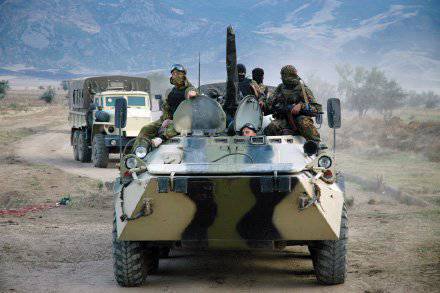 During the air patrolling of the Armenian-Azerbaijani border area near the village of Vagudi, Sisiansky district of the Armenian ASSR, the “knights” found a group of armed people who were near the destroyed kosharas. They landed nearby with four helicopters and surrounded the structure. For the militants, the appearance of special forces was a complete surprise. But despite this, they quickly made to fight. And, bristling in all directions with the barrels of machine guns, they prepared to repel the attack.
During the air patrolling of the Armenian-Azerbaijani border area near the village of Vagudi, Sisiansky district of the Armenian ASSR, the “knights” found a group of armed people who were near the destroyed kosharas. They landed nearby with four helicopters and surrounded the structure. For the militants, the appearance of special forces was a complete surprise. But despite this, they quickly made to fight. And, bristling in all directions with the barrels of machine guns, they prepared to repel the attack.Realizing that any military actions would lead to bloodshed, the special forces commanders began negotiations with the ringleaders of the bandits. At first, they flatly refused to lay down the trunks. In an incredible tension, two hours passed, during which the special forces and the militants kept each other at gunpoint. "Knights" showed composure, withstood this psychological pressure. No one broke, did not break the iron rule: do not shoot without a command. As time went on, the extremists began to run out of steam. The formidable sight of the fighters in the bloodsuit berets strongly diminished their belligerent ardor. Finally, the field commander waved his hand in a doom: "Yours took ...". On that day, 7 mortars, machine guns, 7 machine guns, 5 carbines, 10 guns, 4 self-made grenade launchers, 80 shells, 80 mines and a huge number of cartridges were confiscated from the militants. The total weight of the trophies was more than one and a half tons.
If we talk about combat operations, we should definitely remember that it was in August of 1990 “Vityazi”, together with fighters of Group A of the USSR KGB, who participated in a unique operation to free hostages captured by armed criminals in the temporary detention center of the city of Sukhumi.
That year was two more significant events. In the spring, in the battalion, for the first time in the internal troops, an experiment was undertaken to form a company staffed exclusively by contract servicemen. And in the fall, the first international contact of the special forces of the internal troops with colleagues from abroad took place: in November, the representatives of Vityaz left for an internship in the Cobra special command of the Austrian federal gendarmerie.
Squad to battle
The constant involvement of special forces in the performance of the most complex service and combat tasks led to the next stage in the development of the Vityaz - the creation of a separate military unit. And this happened in May 1991 of the year, when by the order of the Ministry of Internal Affairs of the USSR on the basis of the training battalion of the special purpose 2 regiment of the division named after F. Dzerzhinsky was formed 6-th special purpose detachment. The young special forces detachment continued the chronicle of glorious deeds.
In the spring of 1991, his fighters, in the most difficult conditions of the highlands, conducted a food convoy through the blocked Roki Pass, breaking the economic blockade of the city of Tskhinval, the South Ossetian Autonomous Region, and disarmed several Georgian militants along the way.
In June, the "knights" on the instructions of the command of the troops carried out an inspection of intelligence information on the preparation of extremists for conducting illegal actions in the Moldavian SSR. In November, a blocked Ministry of Internal Affairs building was guarded by the Chechen-Ingush Autonomous Soviet Socialist Republic in Grozny, preventing all extremist attempts to seize weapons and official documents. In December, they participated in ensuring law and order in Vladikavkaz, where the operational situation sharply deteriorated.
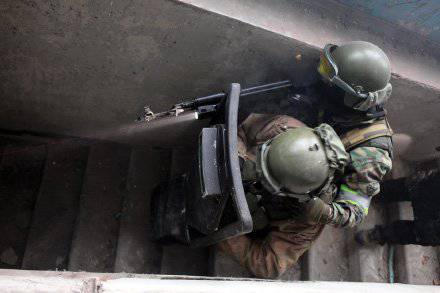 And the next year did not bring peace. In May, the 1992-th “knights” seized weapons from the gangs in North Ossetia, and in Vladikavkaz, the militants of the Teziev group, who were preparing a series of terrorist attacks, were detained and disarmed. In July and October, the representative offices of the Supreme Soviet of Russia in the city of Nazran were guarded. In September, reconnaissance and search activities were carried out in Karachay-Cherkessia with the aim of apprehending and disarming Chechen militants who were trying to enter Abkhazia. In October, the riots in the detention center of the city of Nalchik, Kabardino-Balkaria, were liquidated, and particularly dangerous criminals were detained in the city of Tyrnyauz. In November, detachments of extremists were disarmed, preventing clashes between the warring parties in the zone of the Ossetian-Ingush conflict.
And the next year did not bring peace. In May, the 1992-th “knights” seized weapons from the gangs in North Ossetia, and in Vladikavkaz, the militants of the Teziev group, who were preparing a series of terrorist attacks, were detained and disarmed. In July and October, the representative offices of the Supreme Soviet of Russia in the city of Nazran were guarded. In September, reconnaissance and search activities were carried out in Karachay-Cherkessia with the aim of apprehending and disarming Chechen militants who were trying to enter Abkhazia. In October, the riots in the detention center of the city of Nalchik, Kabardino-Balkaria, were liquidated, and particularly dangerous criminals were detained in the city of Tyrnyauz. In November, detachments of extremists were disarmed, preventing clashes between the warring parties in the zone of the Ossetian-Ingush conflict.In July, 1993, a detachment reintroduced into the Ossetian-Ingush conflict zone, in the area of the village of Ali-Yurt, eliminated gangs that terrorize local residents. And in the autumn of the same year, when against the background of the political crisis in the country, riots broke out with the use of weapons, defended the Ostankino television center.
In those days, extremists seized two armored personnel carriers and thirty vehicles of the division of the internal troops, which arrived in the city to curb the riots. Armed opposition units, inspired by these successes and their own impunity, moved on to the television center. After a stormy rally, the demonstrators moved to action. The building of the hardware-studio complex was fired from small arms, a shot from a hand grenade launcher was fired at it. Grenade flew to the second floor and exploded. A large fragment broke through the strap of an ordinary Sitnikov's bullet-proof vest. The comrades tried to take out the wounded man in the beteer, but the snipers did not allow him to approach the equipment. Nikolai died in the hands of colleagues. October 7 1993, the fighter of the Vityaz squad, Nikolai Yuryevich Sitnikov, was posthumously awarded the title Hero of the Russian Federation ...
Starting in the fall of 1994, the whole story "Vityaz" - a continuous series of special operations to curb the activities of illegal armed groups in the North Caucasus region.
From September to mid-December, the detachment led reconnaissance and search activities on the Chechen-Dagestan border. And the entire second half of December was spent on special measures for the release of servicemen of the regiment of operational assignment of the Volga district of internal troops captured in Khasavyurt on the first day of the introduction of federal troops into Chechnya.
In January, the 1995 “Vityazi” wool settlements along the Mozdok – Chervlennaya – Grozny railway line. In March, they participated in operations to free Argun and Gudermes from militants. In April, they fought a brutal fight with selected thugs near Bamut, where brothers from the Rosich squad got into serious trouble on Lysaya Gora. Faced with the large forces of the militants, they were forced to fight surrounded. A few hours later, during which the “Rosichi” held a perimeter defense, the situation became critical: the detachment, literally bleeding to death, had already had twelve “Two Hundreds” and more than sixty wounded.
It was almost impossible to get through to the besieged: the area adjacent to the unfortunate height was completely swept by the “spirits”, the way was blocked by the river. And yet the “knights”, having received such a task, did it! Having broken through to the little brothers, they immediately entered into a fight. A little later, by a miracle, three detachment armored personnel carriers were able to slip through to the scene of the clash. After that, it was decided to break out of the ring. "Rosichi" carried out from the shelling of their fallen and seriously wounded, "Knights" covered them with dense fire. In that battle, deliberately taking a deadly risk in the name of saving their comrades, they actually demonstrated what the special forces brotherhood means ...
At the end of May 1995, during the destruction of large detachments of militants who settled in the Nozhai-Yurt region of Chechnya, Vityaz had to take a well-fortified, 541,9 height adapted to long-term defense. Already during the advancement from the initial line, the special forces came under heavy fire of militants and rolled back with losses. But, having regrouped and replenished the ammunition, the next day they again rushed forward. They acted decisively and harmoniously. The faithful of the spetsnaz commandment: “We are leaving all or no one is leaving,” they pulled out from under the fire and evacuated the wounded and the dead to the BMP. Under the cover of armor knocked out bandits from the positions.
In January 1996, the “knights” participated in the storming of the village of Pervomayskoye, captured by Raduyev’s gang, who had escaped from Kizlyar together with the hostages after the terrorist attack in this Dagestan city.
To the south-eastern outskirts of the village, the detachment advanced under the cover of helicopters. The initial position was taken by aryk. The first fire contact occurred when the “Knights” reconnaissance unit stumbled upon the advanced guard of the radonets. Without expecting to meet with so deeply wedged intelligence, the militants were unable to respond in time and were destroyed during the short skirmish.
Having come to their senses and taking up the positions left for the duration of the air raid, the Raydayites attempted to drop the commandos. But in vain - the detachment was firmly entrenched on the outskirts of the village. Then the reserves were tightened, and the next day after the artillery preparation, the special forces went on the assault, finding a gap in the enemy’s defense. The detachment managed to make deep raids in the village, to free several hostages. At the same time, twelve fighters, including deputy detachment commander Lt. Col. Oleg Kublin, were injured. "Knights", breaking into the interior of the village, were ready to stand on the conquered land to the last. But for tactical reasons, by order of the senior boss, they retreated to the outskirts of Pervomaisky. The scouts of the detachment were in the center of the village controlled by the militants, risking getting hit by their own aviation. Their intelligence was valuable to the leaders of the operation and contributed to the overall success.
For the special operation in Pervomaisk commander of the Vityaz squad Colonel Alexander Nikishin and his deputy for work with personnel, Lieutenant Colonel Oleg Kublin was awarded the title Hero of the Russian Federation, many soldiers of the detachment were awarded orders and medals.
In 1997 – 1998, the detachment performed combat missions in areas bordering Chechnya. At the same time, hard work was carried out at the point of permanent deployment to improve the educational process, taking into account the experience gained in the performance of combat missions during the first Chechen campaign: everyone was sure that it would still be useful ...
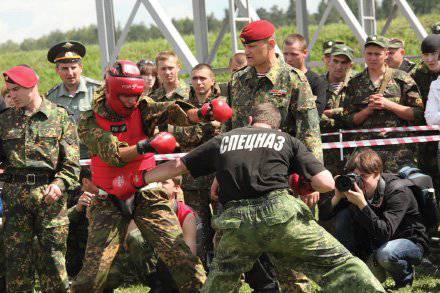 Since June 2000, the “knights” are again in the North Caucasus. Again, one special operation follows another.
Since June 2000, the “knights” are again in the North Caucasus. Again, one special operation follows another.28 March 2002, a detachment that was on a regular combat mission, was tasked with verifying operational information about the whereabouts of a major caches. A few minutes to collect - and the column of the Beteers is already flying towards Argun. The specified area was found quickly, put up a cordon and conducted a reconnaissance. The building of an abandoned school, which was to inspect, stood on a large wasteland. Almost right next to it were several houses, where it was possible to equip a sufficient number of firing points from which everything around would be shot.
The upper floors were cleared quickly, the basement remained. Several assault groups entered it from different directions. The one that included Sergeant Sergey Burnaev, in the very first room, found an artillery shell - a blank for the installation of a land mine. The next few rooms were empty. For further advance, the special forces had to climb over an opening a little larger than the window leaf. Strong guys in body armor with weapons and ammunition to make it was not easy. Sergey, as one of the most experienced in the group, first climbed through the window and began to cover the movement of the others.
Suddenly, from the darkness, several machine-gun fires rang out at close range: gunmen beat out of the embrasure in the wall. Sergeant Burnaev was the closest to the militants. "Spirits" cut off his fire, not allowing the rest to assist Sergei. At this time, the senior group decided to retreat: the ammunition ran out, it was necessary to pull out the wounded. They gave the team and Burnayev. He would have been covered up, but Sergey showed by signs that he would remain and cover the rest himself. Perhaps he saw what others did not see ...
The last of the departed fighters who ran up to the door of the broken batteer froze for a second: there was an explosion in the depths of the basement. One of the militants threw after the "knights" who carried the wounded brothers, a grenade. In a close dungeon, the death of most of the group was inevitable. But Sergey did not allow this: he rushed to the grenade and covered it with his own body ... 16 November 2002, Sergeant Burnaev was posthumously awarded the title Hero of Russia.
23 – 26 of October of the same year, the “knights” together with the staff of the Special Purpose Center of the FSB of Russia released the hostages captured by terrorists in Moscow during the presentation of the musical “Nord-Ost”. And in January, 2003 flew back to Chechnya, where, together with law enforcement officers, they carried out special operations to destroy illegal mini-refineries, and helped the police to check the passport regime, look for legalized militants, and ensure the safety of local authorities.
4 February 2003 of the Year “Vityazi” urgently left for Argun to check up on operational information of exceptional importance. Upon arrival, the group, led by Senior Lieutenant Ivan Shelokhvostov, immediately went to storm the private household, where the militants were hiding. Those met by special forces with heavy fire from machine guns. The officer, having destroyed two bandits, was wounded and ordered his subordinates to retreat. He himself remained inside the building to cover the waste of his fighters and the evacuation of other wounded. From the explosion of a grenade in the house ignited household gas, a fire broke out. Then there was a powerful explosion, the ceiling ceiling and the roof collapsed, burying a courageous officer under him. In that battle, the “knights” managed to destroy, among other militants, the high-ranking field commander Chantaev ... Senior Lieutenant Ivan Shelokhvostov, thanks to the courage and self-sacrifice of which the combat mission was accomplished, was posthumously awarded the title Hero of Russia ...
In October-November 2006, the detachment's consolidated group, in addition to the combat operations in the North Caucasus, successfully completed the particularly important task of the Government of the Russian Federation to assist and ensure the safety of employees of the General Prosecutor's Office conducting an investigation of economic crimes in Vladivostok.
In the summer of 2007, the Vityazi participated in a special comprehensive preventive operation to curb the activities of the bandit underground in Dagestan, recording many victories at their own expense — the destruction of militant bases and training camps for suicide bombers, the seizure of weapons and ammunition.
On August 2, a group led by captain Dmitry Serkov was lying in wait on one of the likely routes of the bandits. Special Forces sappers advanced to set up a minefield, and at that moment the militants appeared. Immediately assessing the situation, Dmitry decided to start a fight to ensure his subordinates a safe withdrawal. During the shootout, he was wounded in the arm. Simultaneously with the commander, the signalman of the group was seriously injured. Removing a bleeding comrade from under the fire, the captain received a second bullet wound, this time in the leg.
Seeing that the special forces were unable to move, the militants tried to get close to them. Having let them in as close as possible, the officer, overcoming the pain, destroyed two more with machine-gun fire and grenades, continuing to exchange fire with the others. "Knights" hastened to the rescue. But at this point, Captain Serkov received a third wound, which was fatal.
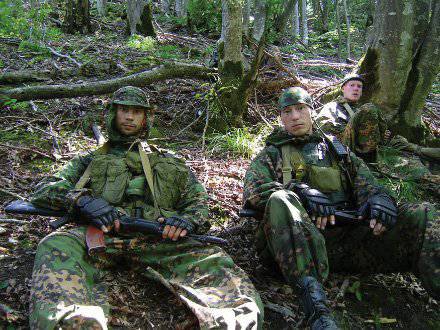
In the course of further fighting, the gang was completely eliminated. Among the killed bandits were two field commanders who had been on the federal wanted list for a long time ... Captain Dmitry Serkov was posthumously awarded the title of Hero of Russia for courage and bravery shown in the performance of military duty.
Center of Glorious Affairs
In September, the Special Purpose Center was formed on the basis of the Vityaz Detachment in September. Since then, its military personnel has almost always been involved in the disarmament and liquidation of illegal armed groups, organized criminal groups, the seizure of illegally stored weapons from the population; in the suppression of acts of terrorism, in ensuring the security of officials and individual citizens of the Russian Federation on the territory of the North Caucasus region. In the course of their combat missions, the Center fighters destroyed 2008 and captured 78 fighters. In the clashes with the bandits, four Special Forces soldiers fell - Senior Lieutenant Dmitry Kozlov, Sergeant Yevgeny Radunsky, Corporal Vadim Stepanov and Sergeant Alexey Sitnikov, who was posthumously awarded the title Hero of Russia. More than 12 soldiers and officers of the CPS awarded state awards.
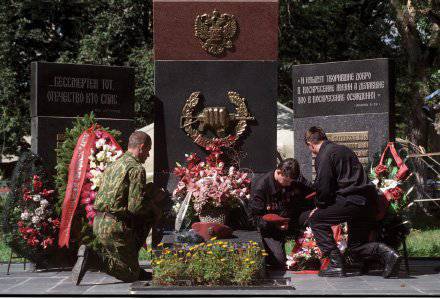 The Center has created and has already undergone the process of becoming highly specialized units, which until now have not been in the special forces of the troops of law and order. This is a group of divers, which has experience in performing combat missions on Lake Baikal, in the Japanese and Caspian Seas, and in water bodies of the Moscow Region. These are groups of gliders and hang-gliders, a division of electronic intelligence and some others.
The Center has created and has already undergone the process of becoming highly specialized units, which until now have not been in the special forces of the troops of law and order. This is a group of divers, which has experience in performing combat missions on Lake Baikal, in the Japanese and Caspian Seas, and in water bodies of the Moscow Region. These are groups of gliders and hang-gliders, a division of electronic intelligence and some others.In recent years, the TsSN fighters are actively mastering mountaineering science and parachute jumping: 2 instructors and 40 excellent paratrooper training personnel trained here, 58 special forces have completed the “Alpinist of Russia” standard. The Center team became the winner of the Russian Ski-mountaineering Championship in 2010 and 2011, and in 2012 it became the best in the country in this sport. This year, the TsSN fighters as part of the Russian national team took part in the ice climbing international ice patrol competition in the Swiss Alps and won prizes.
It is safe to say that the Special Purpose Center, which continues to bear the proud name "Vityaz", is rightfully ranked among the best special forces units not only of our country, but of the whole world.
Information